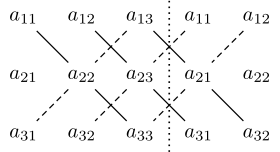Rule of Sarrus

Sarrus' rule or Sarrus' scheme is a method and a memorization scheme to compute the determinant of a 3×3 matrix. It is named after the French mathematician Pierre Frédéric Sarrus.
Consider a 3×3 matrix
then its determinant can be computed by the following scheme:
Write out the first 2 columns of the matrix to the right of the 3rd column, so that you have 5 columns in a row. Then add the products of the diagonals going from top to bottom (solid) and subtract the products of the diagonals going from bottom to top (dashed). This yields:

A similar scheme based on diagonals works for 2x2 matrices:
Both are special cases of the Leibniz formula, which however does not yield similar memorization schemes for larger matrices. Sarrus' rule can also be derived by looking at the Laplace expansion of a 3×3 matrix.
References
- Khattar, Dinesh (2010). The Pearson Guide to Complete Mathematics for AIEEE (3rd ed.). Pearson Education India. p. 6-2. ISBN 978-81-317-2126-1.
- Fischer, Gerd (1985). Analytische Geometrie (in German) (4th ed.). Wiesbaden: Vieweg. p. 145. ISBN 3-528-37235-4.
External links
| Wikimedia Commons has media related to Sarrus rule. |
- Sarrus' rule at Planetmath
- Linear Algebra: Rule of Sarrus of Determinants at khanacademy.org


